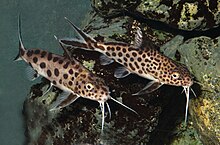Whiskered catfish
| Whiskered catfish | ||||||||||||
|---|---|---|---|---|---|---|---|---|---|---|---|---|

|
||||||||||||
| Systematics | ||||||||||||
|
||||||||||||
| Scientific name | ||||||||||||
| Mochokinae | ||||||||||||
| Jordan , 1923 |
The whiskered catfish (Mochokinae) live with well over 100 species in African fresh waters.
They get their German name from the two lower jaw barbels that are feathered. The pair of barbels of the upper jaw is mostly feathered (except for the type species of the genus Synodontis , S. clarias ). The large, long adipose fin is also striking. A strong, bony head capsule should be noted as anatomically typical. Equally characteristic are strong pectoral and dorsal fin spines, which are mostly toothed and which have long been said to be poisonous. Correct poison glands with a reservoir and a poisonous duct are missing, however. As a recent study by Wright has shown, the poison is produced by venomous gland cells, which are particularly located in the skin surrounding the sting rays. These poison gland cells evidently formed from mucous gland cells in the course of evolution and occur in a large number of catfish families.
Fiederbart catfish, which are popular aquarists, have a striking pattern of spots or stripes, while the majority of the species, especially the genus Synodontis and these in old age, tend to be monochrome in unadorned gray or brown.
Way of life
Some species are schooling fish, others live solitary and are aggressive towards other species. Some species, such as the back swimming Congo Cat ( Synodontis nigriventis ) swim back down and graze the underside of the leaves of aquatic plants. The smallest species, Microsynodontis armatus , is only 2.7 centimeters tall, while Synodontis xiphias reaches a length of 80 centimeters.

The cuckoo catfish ( Synodontis multipunctatus ) and the bigeye cuckoo catfish ( Synodontis grandiops ) lay their eggs under the mouth-brooding cichlids of Lake Tanganyika and let these "hosts" hatch them. The faster hatching catfish larvae eat the eggs and larvae of the cichlids. In this case one speaks of brood parasitism .
In Eastern Europe in particular, Synodontis hybrids are grown under stimulation by pituitary extracts, which are sold en masse to the ornamental fish trade. These species are often sold under the names of Tanganyika whiskered catfish because they are the most expensive to trade.
Vocalizations
In many catfish families, including the Mochokidae , the animals are able to make audible sounds. When annoyed, they rub a dorsal bone process of the pectoral fin ray in a joint groove. The sounds arise both when moving the pectoral fin forward and backward. The spreading of the pectoral fin is slower and the sound is accordingly longer than when it is pulled. The pauses between the sounds are equally long. The greatest energy of the sounds is between 2 and 4 kHz. The Mochokidae differ z. B. of the Doradidae only through the faster movement of the pectoral fins, ie the sounds and the pauses between the sounds are shorter than in the Doradidae.
Systematics
Family Mochokidae Jordan, 1923
- Subfamily Fiederbartwelse (Mochokinae Jordan, 1923 )
- Genus Acanthocleithron Nichols & Griscom , 1917
- Acanthocleithron chapini Nichols & Griscom, 1917
- Genus Zwergfiederbartwelse ( Microsynodontis Boulenger, 1903 )
- Genus Mochokiella Howes, 1980
- Mochokiella paynei Howes, 1980
- Genus Mochokus Joannis, 1835
- Mochokus brevis Boulenger, 1906
- Mochokus niloticus Joannis , 1835
- Genus Synodontis Cuvier, 1816
- List of species see Synodontis
- Genus Acanthocleithron Nichols & Griscom , 1917
Individual evidence
- ^ Wright, JJ (2009): Diversity, phylogenetic distribution, and origins of venomous catfishes. BMC Evolutionary Biology , 2009, 9 : 282. ( PDF )
- ↑ AM Kochetov (2002): New cultivated forms of Synodontis njassae KEILHACK, 1908. Aquaristik Fachmagazin 164: 111-112.
- ^ S. Grant (2003): Synodontis sp. "Zebrinus" (Siluriformes: Mochokidae). BSSW Report, 15 (3): 16-24.
- ↑ Wolfgang Pfeiffer: The sound generation of the Dornwelse (Doradidae) and the Fiederbartwelse (Mochokidae) . ( PDF ) In: Zoomorphology . 54, 1965, pp. 669-679.
Web links
- Fiederbartwelse on Fishbase.org (English)
- John P. Friel , Thomas R. Vigliotta. 2009. Mochokidae Jordan 1923. African Squeaker and Suckermouth Catfishes. in The Tree of Life Web Project
- Fiederbartwels Synodontis Petricola - Contribution by Hans Georg Evers

